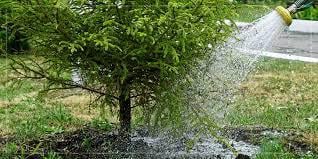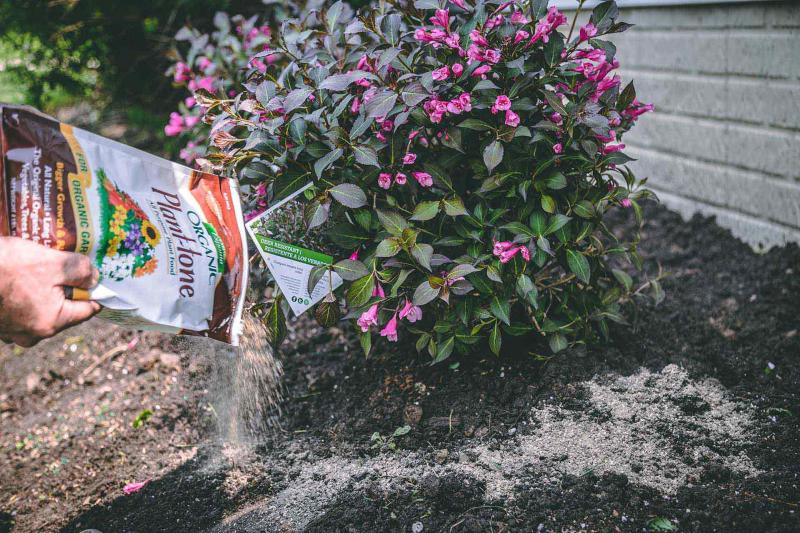Plant Care & FAQ's
At Meadowbrook Gardens, we know how important your property is to you. Therefore, we have compiled an aftercare guide to help you maintain your newly installed landscape and keep it looking its finest. In it you will find information that answers the most frequently asked questions. As always, please contact us if you have any questions regarding your landscape.

How often should I water Newly Installed Trees & Large Shrubs?
Water trees and shrubs with a normal garden hose or one fitted with a nozzle using a slow trickle. Depending on rainfall, trees should receive 20-30 minutes of watering and shrubs 5-10 minutes each. For trees, using a garden hose, 5-10 gallons of water is recommended. For shrubs, 2-4 gallons of water is recommended.
During the spring and fall months, water plantings twice per week. During the summer months, water two to three times per week.
When in doubt, feel soil about 3” down. If moist, walk away and recheck in a day or two. Please note that guidelines are for loamy soil. Sandy soil will require slightly more water, clay soil slightly less water.
How often should I water newly Installed Perennials, Small Shrubs, and Ground Covers?
In general, freshly installed annuals should be watered every day. Our knowledgeable staff will be able to help you with the individual watering needs of your perennials, small shrubs, and ground covers for both the new-installation period and for long-term care.
For these smaller plants, a sprinkler works just fine. Turn the sprinkler on during the day (preferably in the early morning or late afternoon, when the temperature is not at its peak), and let it run for approximately 2 hours. ***Please note that a plant’s watering needs are affected by weather, sun, and soil conditions.


Should I Fertilize my Newly Installed Plants?
Meadowbrook Gardens includes an initial organic fertilization with all our plant installations. Therefore, it is not necessary for you to add any fertilizers to your new landscaping this year. However, every spring you should apply new fertilizer.
We strongly recommend Plant-Tone for most plantings, with Holly-Tone for all broadleaf and narrow leaf conifers (except boxwood), dogwood, ferns, hydrangeas, magnolias, oaks, and pachysandra.
Trimming and Pruning Tips
In general, trimming dead or crossing branches and unwanted growth whenever they appear is fine. Just be sure that you do not trim more than one-third of the plant at any given time. With newly installed trees and large shrubs, it is best not to prune or trim more than is absolutely necessary. This is because you do not want to over-stress the plants as they adjust to their new environment.
Early spring and late fall are the best times to trim your new plant material. Once desired size of plant is achieved, you will want to keep it trimmed to that height. If you allow your shrub to get large, and then try to trim it back, it will result in a bare and “branchy” shrub.


Mulching Guidelines
Mulch helps the soil in planting beds retain water, reduces soil temperature fluctuations, retards weed growth, helps reduce soil erosion and compaction, and provides nutrients to the soil as it breaks down. Mulch should be spread evenly to about 2 to 3 inches in depth. Do not pile too much mulch under shrubs or around the base of tree trunks. You want to keep these areas as clear as possible, which means a thin layer is all you need.
When your landscaping was installed, Meadowbrook Gardens laid down the proper amount of mulch for your project, so you will probably not need to spread more for at least the next 6 months to a year. The exception to this would be if extreme weather conditions in your area (such as flooding, severe rain, or snow melt run-off). You may want to turn your mulch in a few months to revive color lost to sun fading.
Each spring you will want to top coat your beds with fresh mulch. The mulch in your planting beds should be watered along with your plants so that it is nice and moist. Let the mulch dry out between watering, but not to the point of cracking.
Try not to water on heavily overcast or rainy days, as this will result in fungus (such as mushrooms) or mold. Following these steps will help keep your planting beds healthy and looking good.
